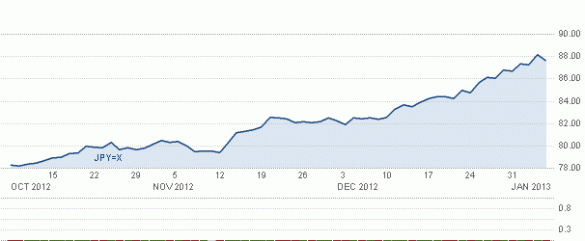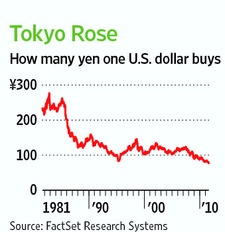Archive
Japan’s Child Pop. shrinks By 150,000 to a record low

India has more children than the total population of any country in the world – except China.
|
 f people are becoming richer, more educated, in better living conditions, in a technologically superior time than any other in history, why can’t they afford children?
f people are becoming richer, more educated, in better living conditions, in a technologically superior time than any other in history, why can’t they afford children?
Earlier, when the father alone could raise a family of ten, today’s parents are afraid that, “even two incomes are no longer enough to make ends meet before pay day.”
You Pay For This …
The One Big reason that parents in the West and Japan are not having children is because of the cost.
Sheer economic costs.
A recent post in the Newsweek elicited much discussion and reactions – broadly falling into two categories.
Personal financial limitations and difficulties and social values on the other hand.
Apart from a sermonizing David Cameron, in UK, a recent report suggested that just one child, “a child from birth to adulthood will cost £140,000. This means the average couple works two years to fund each offspring – couples with children are twice as likely to file for bankruptcy as those without.”
The Other Big reason is, Western social and political leaders have made it uncool to have children.
Like this French woman-writer, Corinne Maier, who, disturbed at an exhibition of Belgian surrealists, decided, “at that point, I thought, ‘I really regret it, I regret having children.’ ” Her subsequent book, “40 Reasons for Not Having Children” in French, was also translated and sold well in English.
An American ‘comedian’ Adam Carolla was caught moralizing: “The best parenting of all is not shitting out the kids when you can’t afford the kids.”
The last word on this.
The Optimum Population Forum judges the price of a condom to have had a nine million per cent “return on investment” when set against the cost to the planet of having a child.
In such a moral atmosphere, which self-respecting set of parents would start a family?
It is a brave child, who dares to come into this kind of unwelcome society.

This over-production, over-waste, over-war model can change. How about a 2ndlook? | Cartoon by Steve Greenberg on Oct. 22, 1994. in Seattle Post Intelligencer. For an updated cartoon – http://goo.gl/r9HLa
Am I Backward?
Why is the ‘developed’ world choose to commit a ‘demographic’ suicide.
Beats me!
But then, by common consensus of the superior Western media and its Brown-American cheerleaders, I am from an under-developed country like India.
Can I even begin to understand ‘development’?
By the way, here are the latest stats on the self-inflicted genocide of Japan.
As the nation celebrated the national Children’s Day holiday on May 5, the number of children under 15 years of age fell 150,000 from a year earlier to a record low 16.49 million as of April 1, according to government estimates released on May 4.
The child population shrank for the 32nd consecutive year and hit the lowest level since statistics became available in 1950, the internal affairs ministry said.
The estimates, based on national population census and other surveys, were compiled for Children’s Day on May 5.
Those under 15 years of age accounted for 12.9 percent of the total population, one of the lowest levels in the world. The corresponding figure is 19.6 percent in the United States, 16.5 percent in China and 15.6 percent in South Korea.
According to the estimates, there were 8.44 million boys and 8.04 million girls. By age, 3.55 million were between 12 and 14; 3.4 million were between 9 and 11; 3.2 million were between 6 and 8; 3.17 million were between 3 and 5; and 3.16 million were between 0 and 2.
via Child population shrinks 150,000 to record low 16.49 million – AJW by The Asahi Shimbun.
By the way, the Indian children are nearly 31% of the gross population – and India has about 44 crore children.
India has more children than the total population of any country in the world – except China.
Related Articles
- Japan’s child population falls for 32nd year in row (english.kyodonews.jp)
- Lessons From Record Decrease in Japan’s Population (quicktake.wordpress.com)
- Over 2,000 fewer farmers every day (thehindu.com)
- Bogus ADHD diagnoses on the rise (douglassreport.com)
- Japan’s population falls by record level (japantimes.co.jp)
- Japan: The worst developed country to be a mother? (bbc.co.uk)
- Leave them alone (guardian.co.uk)
- China’s one-child policy increasingly being questioned (pri.org)
- Saving Japan: promoting women’s role in the workforce would help (japantimes.co.jp)
Lessons From Record Decrease in Japan’s Population

This commitment by Indian society to universal, lifelong marriage has attracted many, especially women.
|

ukushima, Hiroshima, Nagasaki are the not the only nuclear disasters that have hit Japan. The bigger disaster is unfolding in slo-mo.
Japan’s population has dropped by a record 284,000.
As of Oct. 1, 2012, the country’s population was estimated at 127,515,000, down 0.22 percent from the previous year, the Ministry of Internal Affairs and Communications said April 16.
The decline is the largest in both number and rate since 1950, when comparable figures were first available.
The population dropped for the second year in a row for the first time.
Japanese society continues to age, with the population of elderly, aged 65 or over, estimated at 30,793,000, up 1,041,000 from the previous year. It was also the first time that the elderly outnumbered children, aged 14 or under, in all 47 prefectures.
The natural decrease, or the difference of deaths and births, was the largest ever at 205,000. This marked the eighth straight year of natural decrease for men and the fourth straight year of natural decrease for women. By prefecture, Tokyo, Saitama and Chiba marked the first instance of a natural decrease.
via Record decrease in Japan’s population – AJW by The Asahi Shimbun.
Maya means … Propaganda … ?
The only reason India is not sitting on a demographic time bomb, is because of our देसी मन्द बुद्धि desi-mand buddhi (rustic minds). Especially from the Indo-Gangetic plains.
This देसी rustic mindset that our ruling elites look at with contempt, did not get fooled by the massive propaganda drive by the West – using the Indian State as its agent.
Not Individuals … But Families As Building Blocks Of Society
The Indian system of family stability is based on three principles: –
1. Universal marriage. In the rest of the world, the rich marry, the poor: –
- Forever chase ‘relationships’
- Associated with prostitution
- Become users of pornography
2. New families funded by families and relatives with income stream from property, profession, business for groom and and start-up capital of gold to bride.
3. Since, all girls and boys, especially during periods of social chaos, political instability (like British Raj) may not find matches, marriages are arranged by social ‘intervention’ to keep the system of universal marriage functional.
People Know …
This commitment by Indian society to universal, lifelong marriage has attracted many, especially women. Indian men are seen by Russian women as ideal husband material. On the other hand, apart from the staggering levels of prostitution, sex-deprivation has triggered a wave of sexual-abuse of children across Europe and US. Widely, but not limited to the Catholic Church system.
Charity … Anyone?
This pattern of sexual misbehavior has claimed a life this time.
Peter Roebuck, a cricket player-coach-writer recently jumped to his death from his 6th floor hotel room in South Africa. After receiving a suspended sentence in an British court for not-so deviant behavior with his South African trainees, he emigrated to Australia.
Similarly, in India too, we have seen these various do-gooders use their ‘charity’ work to gain access to unwilling sexual partners.
Promoted by the Desert Bloc ‘system’ is
– Sexual repression in the masses
– An impossible marriage mechanism with crazed alimony system
– Antagonistic and confrontational gender relations
– A flourishing prostitution industry
– A distorted religious system that promotes celibacy
Charity seems like a facade for gaining access to sexual partners in all these cases. The cause may be the sexual repression rather than dubious charity.
Islamic Demographics
Indian Muslim population is growing because they have persisted with the Indian family model. In West Asia, Islamic populations are meager and much below Indian growth levels. Muslim populations are increasing only in countries where Indian influence is strong – and therefore commitment to universal marriage is strong. India, Pakistan, Bangladesh, Indonesia.
Meher system in all these societies (India, Pakistan, Bangladesh, Indonesia) is nominal, weak. The day Muslims (from India, Pakistan, Bangladesh, Indonesia) become ‘fully’ Muslim, implement the Meher system, their populations will start decreasing.
The only two countries that has come close to India in this metrics are Indonesia and China. Thanks to Mao and Western propaganda, in China that has changed. Progressive Liberals in India are desperate to implement the Chinese model in India also – in connivance with the West.
Seems like Russian women know more about marriage …
Related Articles
- Perils of voyeurism (thehindu.com)
- Sexual repression (lunaticoutpost.com)
- Japan’s population falls by record level (japantimes.co.jp)
- Teen says parents forced her into one-month marriage (foxnews.com)
- “so over marriage equality” – The Feministing Five: Kate Bornstein (thefemmetasticfeminist.wordpress.com)
- Bulgaria with EU’s Lowest Marriage Rate (novinite.com)
- American counties hollow out from aging, finance crisis and youth migration (wired.com)
- Census shows record 1 in 3 US counties are dying (miamiherald.com)
- India is set to become the youngest country by 2020 (thehindu.com)
- Record number of counties losing population (sfgate.com)
Defense Technology: A World Of Haves & Cannots

In the last 70 years, technology gaps in defence have increased hugely. US and Russia are far ahead from rest of the world in making arms and armaments.
|
 big drawback that hobbled Japan in WWII was oil. Japan had aircraft carriers and fighter aircraft – but little oil. In each battle, in the decisive stages of the WWII, oil was in short supply. By the start of WWII, Japan was prepared for war, with its Zero fighters.
big drawback that hobbled Japan in WWII was oil. Japan had aircraft carriers and fighter aircraft – but little oil. In each battle, in the decisive stages of the WWII, oil was in short supply. By the start of WWII, Japan was prepared for war, with its Zero fighters.
In the last 70 years, technology gaps in defence have increased hugely. Countries like India have decided to build their defence capability by importing the latest and the best on one hand. On the other hand, India has launched ambitious R & D projects that are getting close to world standards.
US and Russia are far ahead from rest of the world in making arms and armaments. Coming close to these countries will take decades and billions of dollars – two things that very few countries have. For instance, few countries in the world (US, Russia, UK, France, Italy) can make world-class jet engines for fighter aircraft. Even countries like Japan and Korea, with a strong electronics and industrial base depend on defence imports.
For WWII, Japan produced more than 10,000 fighters – including the famed Zero fighter.
Masahide Ishizuka, 52, a New Zealand resident originally from Tochigi Prefecture is campaigning to bring one of the four airworthy Zero fighter aircraft in the world back to Japan, where it can fly again in the skies of its homeland.
The Mitsubishi A6M Zero, the mainstay of the Imperial Japanese Navy, was produced by Mitsubishi Heavy Industries and Nakajima Aircraft. Japan produced about 10,000 carrier-based Zero fighter aircraft during World War II.
In the early stages of the war, the Zero gained a reputation as a fearsome dogfighter with its slick maneuverability, long-distance range and high speed–three important attributes of fighter aircraft.
All four airworthy Zeros today are registered in the United States.
The Zero, a Mitsubishi-produced A6M3 Type 0 Model 22, was found in the 1970s in Papua New Guinea, and was restored to airworthiness by the U.S. collector.
via Aviation expert hopes to return Zero fighter to skies over Japan – AJW by The Asahi Shimbun.
Related Articles
- Japan sends jets after Russian planes (cnn.com)
- 70 years later, a WWII pilot soars once more in a Flying Fortress (warhistoryonline.com)
- F-35 Joint Strike Fighter: Singapore’s Next-Generation Fighter? – Analysis (eurasiareview.com)
- WWII Bombers Fly In To Tallahassee Airport (wctv.tv)
- Canada unsure what will replace Hornets (upi.com)
Currency Trade: War or Peace?

Now that Japan has joined the currency devaluation game, it leaves the Euro twisting in the winds of currency storms.
|

The yen, trading at about 87 per dollar, has shed about 11 percent since mid-November when Shinzo Abe, who became Japan’s new prime minister following elections last month, promised a more aggressive monetary policy. | Graphic source & courtesy – cnbc.com
 iven a choice between a Japanese car and Chinese, almost any car buyer in the world will opt for a Japanese brand.
iven a choice between a Japanese car and Chinese, almost any car buyer in the world will opt for a Japanese brand.
If price difference is small.
But as we know the price difference between Japanese and Chinese cars (and other products also) is rather big.
The big reason for this price difference?
The Japan Case
Though not the only reason, the high cost of the Japanese Yen after the Plaza Accord (September 22, 1985) has painted the Japanese economy into a corner.
Japan on Thursday reported a record annual trade deficit in 2012, the second straight year in the red for an exporting nation that has long built its wealth on its vast trading surpluses.
The annual trade gap of 6.93 trillion yen (about $78 billion) was brought about by surging fuel imports and a continued slide in machinery shipments and other mainstay exports. The deficit underscores the challenges Prime Minister Shinzo Abe faces as he tries to lift the world’s third-largest economy out of years of stagnation.
The deficit also brings to the forefront the risks that accompany Mr. Abe’s bid to revive the economy through government spending, which will add to Japan’s public debt, already more than twice the size of its economy. For years, export surpluses helped Japan finance that enormous debt without having to turn to foreign investors.
But that delicate balance is now unraveling. The global economic crisis set off a fall in Japanese exports, and also caused the yen to strengthen, weighing on the country’s competitiveness and recovery. The prolonged shuttering of the country’s nuclear reactors in the wake of the Fukushima crisis has led to a spike in Japan’s imports of oil and gas. A bitter territorial spat with China has hurt exports to Japan’s biggest trading partner.
The provisional data released by the Finance Ministry on Thursday showed exports continued to fall in December at a faster pace than forecast by economists, despite a weakening of the yen that should have come as a boon to exporters.
According to the data, Japan’s annual trade deficit jumped by 170 percent from the 2.56 trillion yen shortfall it recorded in 2011 to 6.93 trillion yen. Energy imports, mainly from the Middle East, surged, machinery and car exports fell across the board. By region, Japan’s exports to China tumbled by 10.8 percent, leaving Japan with a trade deficit of 3.52 trillion yen (about $40 billion) with its rising neighbor. Exports to the struggling European Union also fell by 15 percent.
Trade with the United States was brisk, however, with exports climbing 11.7 percent and imports by 2.5 percent for a 5.1 trillion yen (about $58 billion) surplus. Japanese automakers did particularly well in the United States last year, rebounding from production cuts brought about by Japan’s 2011 tsunami.
via Japan Reports a $78 Billion Trade Deficit for 2012 – NYTimes.com.
The expensive Yen has increased the price of Japanese exports. Decreasing export-growth due to an expensive Yen, has led to a 20-year economic stagnation-deflation situation in Japan – now referred to as Japan’s Lost Decades (失われた10年 Ushinawareta Jūnen).
Could Japan’s actions to depreciate the Yen have been unilateral?
Highly unlikely.
Japan is the latest country to say enough is enough. Having seen its currency appreciate dramatically in recent years, prime minister Shinzo Abe’s new government is taking steps to alter the country’s exchange-rate dynamic – and is succeeding. In just over two months, the yen has weakened by more than 10% against the dollar and close to 20% against the euro.
via Currency war could cause lasting damage to world economy | Business | guardian.co.uk.
Japan’s new government has vowed to revive the economy and expectations for aggressive monetary easing are running high. This sets the scene for the yen to weaken to the 100-mark versus the dollar.
The yen, trading at about 87 per dollar, has shed about 11 percent since mid-November when Shinzo Abe became Japan’s new prime minister last month, promised a more aggressive monetary policy.
Keen to tackle the deflation that has dogged Japan’s economy for years, “The yen has fallen quickly and once it gets going, it gets going. What kind of number (in dollar/yen) do you need to fight deflation? I think we need to see dollar/yen at 110, 20 to say you’re on top of the deflation problem,” Jerram added.
Inflation in Japan fell 0.2 percent in November from a year earlier, after a 0.4 percent decline in October. A weak currency, brought about by aggressive monetary easing would help boost inflation, analysts say.
Japan’s current account surplus fell 29.4 percent in October from a year earlier to 376.9 billion yen ($4.58 billion) on a fall in exports.
They say another reason to expect further yen weakness this year is a brighter outlook for the global economy, which means there is more incentive for Japanese investors to put their money overseas.
“Everything is in place for a move in dollar/yen to 100, the only constraint being resistance from other major central banks to anyone else adopting a weak currency,” Societe Generale said.
The Chinese Knot
A cheaper Japanese Yen affects China the most.
Any major currency appreciation, devaluation in the last 60-years has happened under the (what 2ndlook calls) USCAP system.
So, the noises being made of currency wars by Germany is probably to quieten other claims for currency depreciation – like Korea, Euro zone, Taiwan, Asian Tigers, et al.
China seeks to replace the former Soviet Russia as the challenger to Pax Americana. This challenge by China to Pax Americana is based on manufacturing prowess and huge foreign currency reserves.
China’s Yuan has already appreciated to a 20-year high. In the current global scenario, China’s currency situation puts it in a weak situation. China’s economic engines will seize, if the Japanese Yen were to depreciate to ¥110-120.
EU’s Sports Complex
The interesting point is how EU manages its trade deficit. Without blaming China-Yuan.
EU-zone countries like Greece, Ireland, Italy, Portugal, Spain, are on the verge of a sovereign default. Euro-zone is upto its gills in debt. The Euro is being called names. And EU is not snivelling about the Yuan and China?
Very un-European!

USA, EU Trade Balance with Oil Producers (Graphic source and courtesy – http://www.eurotrib.com). Click for larger image.
Usually…
Europe is at the forefront seeing dangers, damage, affronts, threats, effects, fall-outs et al.
The whole she-bang!
But in case of China and Yuan, Europe is not doing much of crying about the ‘undervalued’ Yuan. The Euro revaluation from USD 1.6 four years ago to USD 1.25 now is a recent affair.
So, not of much consequence. The Yuan undervaluation has been on the US agenda for a few years now – with varying intensities. Euro-trade balance with China is slightly in China’s favour. All in all, good management by the Euro-zone, it appears.
Which in the current scenario is the one-bright-spot on the Euro-horizon!
In today’s world, no significant group of countries is looking for currency strength. Some resist appreciation actively and openly; others do so in a less visible manner. Only the eurozone seems to accept being on the receiving end of other countries’ actions.
via Currency war could cause lasting damage to world economy | Business | guardian.co.uk.
The German Footprint
Behind the Euro-zone is the Germanic template.
In the last twenty years, Germany has absorbed East Germany, without a hiccup. During the same period Japan entered into a deep stagnation-deflation phase – but not Germany. While the world succumbed to Chinese manufacturing onslaught, the German industrial complex kept humming – steadily. While the US economy stumbled from bankruptcy of the auto-industry to the dotcom bust and is now deep into the housing crisis, the German economy remained stable.
All this without seeking competitive currency devaluation.
countries nowadays, including systemically important ones, are already actively weakening their currencies. Yet, because an exchange rate is a relative price, all currencies cannot weaken simultaneously. How the world resolves this basic inconsistency over the next few years will have a major impact on prospects for growth, employment, income distribution, and the functioning of the global economy.
via Currency war could cause lasting damage to world economy | Business | guardian.co.uk.
Wars Before The War
WWII was preceded by 15-years (1921-1936) of currency devaluations. Will history repeat? Will the US take a break after ending the Afghan War in 2014 to start WWIII?
Related Articles
- Japan reports record $78.3B trade deficit in 2012 (miamiherald.com)
- Yen at 100 Per Dollar Endorsed by Japan Official Nishimura – Bloomberg (bloomberg.com)
- Japanese Export Slide Bolsters Abe’s Case for Driving Down Yen – Bloomberg (bloomberg.com)
- Business › Japan reports record Y6.93 tril trade deficit in 2012 (japantoday.com)
- Japan min-not trying to weaken yen, central bank (uk.reuters.com)
- Japan minister: not trying to weaken yen, central bank (news.yahoo.com)
- Japan December Industrial Output Rises Less-Than-Forecast 2.5% – Bloomberg (bloomberg.com)
- Dollar Thrives in Age of Competitive Devaluations – Bloomberg (bloomberg.com)
- Better Factory Output, Lower Manufacturing PMI Contraction Put Japanese Economy On The Path Of Recovery (ibtimes.com)
- Japan runs record trade deficit (bbc.co.uk)
Governments get into dating game

Governments across the world are actively involved in our private lives – including whether we should have any, some or many children.
|
Less, more and many
From Moscow to Montreal, Beijing to Berlin, America to Australia, the world is facing a serious population problem.
With the spread of Desert Bloc culture, marriages are becoming less frequent, unstable with shorter spans. Prostitution is booming.
The only people able to face this onslaught without succumbing, are the ‘uneducated’ Indians. They are the only people who rejected Western advice on family size, late marriages.
USA, parts of Europe manage by importing immi-grunts’. From India and Africa, the only regions largely unaffected by the Desert Bloc model.
Knife-edge
China, Japan are now paying the cost for using the Desert Bloc model on family planning.
The situation is so precarious that in Japan,
Regional governments are now offering programs for single men and women to meet, even helping them hone their relationship-development skills. To learn the nooks and crannies of these publicly sponsored mixers, The Nikkei paid a visit to the Aichi Prefecture city of Tokai, a Nagoya suburb with a population of about 100,000.
In 2010, the city officially pledged to help people find their future spouses. (via Governments get into dating game).
To overcome the inertia of the Indian Government, Western countries are pouring money into Indian NGOs – at the rate of US$2 billion each year.
This is more than the official aid that the whole of Africa gets – or what Egypt or even Pakistan gets.
If you are believer
A few months ago, Carnegie group a long time supporter of population control dogma, commissioned a study to find evidence of how massacres and wars helped to preserve environment and ecology balance. The heroes of this study were Genghis Khan, Atilla, etc.
To such people I have a simple message.
Related articles
- Desert Bloc Justice – Innocence Isn’t Enough (2ndlook.wordpress.com)
- Church, Religion & Go-Gooders (behind2ndlook.wordpress.com)
- Hit me with your best shot (2ndlook.wordpress.com)
WWII Propaganda: 70 years later

At least this Nazi was correct about Churchill. The caption: “I am the friend of all the small countries!” Winston Churchill removes his mask. A standard Nazi propaganda argument was that England used smaller nations, tossing them aside when they were no longer useful. Source and courtesy : bytwerk.com). Click for larger image.
Trade wars are, perhaps, the most serious threats to the global economic order. Because of that, they are also the least likely. So, while the current rumblings in Beijing and Washington may lead to increased frictions, even economically ignorant politicians will not do anything drastic.
Both Germany and Japan tried in the 1930s to limit unemployment and political vulnerability by maximising domestic production and restricting imports. But, since World War II, economic activity has increasingly crossed political borders. (via Mutually assured destruction).
Is this plain ignorance?
Given that Reuters is a British news agency, the propaganda motive can never be discounted. The author forgets that Germany, home of the automobile (inventors of petrol and diesel engines, and the motor car itself), Italy and Japan were significantly industrialized countries before WWII. These countries were shut out of colonial markets with high tariff barriers by Britain and France.
In India
Even after crippling tariffs, industry from Germany, Italy and Japan was able to stand up to British and French products. For instance during the Great Depression, the British Raj imposed a towering 75% duty on Japanese mill cloth to India – which was becoming highly popular. In turn the Japanese stopped buying cotton from India. British mills made a killing by then buying Indian cotton at throwaway prices.
What of the Lees-Mody Pact?
While the Churchill Norman extraction of gold continued to bleed the Indian peasant, such trade barriers further damaged the Indian economy. Edward Hadas surely knows this.
Why this propaganda – 70 years after the start of WWII?
Related articles
- The Atlantic’s WWII Photo Series (paul.kedrosky.com)
- Starving India to India Starring (behind2ndlook.wordpress.com)
- Faction Fueds of Desert Bloc – Should India Get Involved? (behind2ndlook.wordpress.com)
- How Did Adolf Hitler Utilize Propaganda as a Tool to Further His Means, and What Different Factors Allowed It to be So Widely Effective? (socyberty.com)
- Who was worse Hitler or Churchill (wiki.answers.com)
National Ratings – What Is The World Coming to?
Examining governance records of selected ten premiere post-WWII governments across the world could throw up some surprises.

Momentum and direction is half the story. The Other Half is more difficult. (Cartoon by Bill Leak; Courtesy - cagle.com). Click for larger image.
Any flavour – as long as it is socialism
With a global recession staring at the world, unemployment at record levels, gold prices in the stratosphere, there is need to understand where nations – and their country-models are going. Communism has failed, Capitalism died with end of African slavery – and in a world made of socialist flavours, it may be worthwhile to understand what works – and for how long.
Maybe you should read more about भारत-तंत्र Bharat-tantra.
Performance and propaganda
If we are to examine governance records of selected ten premiere post-WWII governments across the world, a lot of State propaganda will stand exposed. To enable a broad understanding of national direction – based on historical milieu, current context and future prospects, a country Rating Engine is available.
10 nations have been chosen. Four from Europe (France, Germany, Italy and UK), two from South America (Argentina and Brazil) Japan and USA, China and India. Looking back at the 65 years after WWII (1945-2010), the context and strategies of these ten countries throws up some surprises.
10 Country Rating Engine
For purposes of this post, a 10-country snapshot has been presented with a Rating Engine. The Rating Engine can be used to measure performance on three parameters.
-
Relative Decline or Rise From WWII-to Now
-
Current Status
-
Country Outlook Over the Next 10-25 Years.
Readers can do a country wise rating on these three parameters, for each country. Cumulative ratings will appear instantly.
 |
USA – the world’s largest economy. |
|
Rise or Decline (1945-2000)
|
Today
|
Future
|
|||||
|
|
|
 |
Britain – The Grand Phuski (or also The Great Damp Squib) |
|
Rise or Decline (1945-2000)
|
Today
|
Future
|
|||||
|
|
|
 |
Argentina – The Land Of Missed Opportunities |
|
Rise or Decline (1945-2000)
|
Today
|
Future
|
|||||
|
|
|
 |
Brazilian Success – Resounding and Recent |
|
Rise or Decline (1945-2000)
|
Today
|
Future
|
|||||
|
|
|
 |
The French Success Model |
|
Rise or Decline (1945-2000)
|
Today
|
Future
|
|||||
|
|
|
|
|
|
Loser’s Miracle The three most ‘impressive’ examples of economic resurgence have been the losers of WWII – Germany, Italy and Japan. Significant industrial nations before WWII, it is no co-incidence that these three economies came together on one side to fight WWII – against colonial powers, Britain and France. |
 |
The Japanese Miracle |
|
Rise or Decline (1945-2000)
|
Today
|
Future
|
|||||
|
|
|
|
|
 |
The Italian Job |
|
Rise or Decline (1945-2000)
|
Today
|
Future
|
|||||
|
|
|
|
|
 |
The Rise and Rise of Germany |
|
Rise or Decline (1945-2000)
|
Today
|
Future
|
|||||
|
|
|
|
|
 |
China – The Jade Garden Blooms Again |
|
Rise or Decline (1945-2000)
|
Today
|
Future
|
|||||
|
|
|
|
|
 . . |
India – What is The Difference |
|
Rise or Decline (1945-2000)
|
Today
|
Future
|
|||||
|
|
|
|
|
Related articles
- Lethargy As Opinion (quicktake.wordpress.com)
- The Atom Bomb Didn’t End WWII? (andrewsullivan.thedailybeast.com)
- Moody’s downgrades Japan’s debt rating (usatoday.com)
- Gold Standard: Forty Years Gone – And Good Riddance (blogs.wsj.com)
- Lethargy As Opinion (quicktake.wordpress.com)
- The Atom Bomb Didn’t End WWII? (andrewsullivan.thedailybeast.com)
- Moody’s downgrades Japan’s debt rating (usatoday.com)
- No Prisoners! Survivors? None (2ndlook.wordpress.com)
- Crisis in Global Politics? (quicktake.wordpress.com)
- WWII Propaganda: 70 years later (quicktake.wordpress.com)
- Corruption – The American Method (quicktake.wordpress.com)
- Twitter / @dhume01: On Inept Indian Politicians (quicktake.wordpress.com)
The shadow of oil

Middle East Politics (from Coming apart, coming together By Edward R. Kantowicz; Page 165; courtesy - books.google.com). Click to go to source.

Is Pax Americana like Britain was a hundred years ago? (Cartoon courtesy - mpg50.com.). Click for larger image.
Fat and lazy
Between 1875-1935, Britain was dependent on India for gunpowder, on USA and Iran for oil, on Malaya and India for rubber. British economy had grown fat and uncompetitive – unlike Italian, German and Japanese economies.
Even though Britain won WWII, their economy was a lost cause. Though Germany, Italy and Japan were losers, with their economy in shambles, they could make a brilliant recovery and vastly out-compete Britain.
The story of Middle East oil is similar for USA and West. The Welfare State, built on a diet of cheap oil, easy dollars, is now too expensive for the West to sustain. The above book extract gives an excellent snapshot of the oil industry in the 20th century.
And the shadow of oil on the 21st century.
Related articles
- Onward, American Soldiers! Another million await death. (quicktake.wordpress.com)
- Out with the old? (bbc.co.uk)
- UK economy trailing (thesun.co.uk)
- Skidding Oil Prices: A Blip or a Trend? (green.blogs.nytimes.com)
Boozed British journalism cant see straight

Why compare Japan with Lat-Am and Zimbabwe? Why not with USA, China and Germany which is more like in Japanese class! (Cartoonist - Clay Bennett, from Clay Bennett's Editorial Cartoons; courtesy - cartoonistgroup.com.). Click for larger image.
An Indian problem
Now one of the problems of India, having English as an important language, is the amount of swill, garbage and propaganda that we are subjected to.
In spite of being less than anybody, British media can be pretty biased.
One example was a post by Ian Campbell on Japan’s economic problems. He says,
Japan has … has the worst debt to GDP ratio among major economies … But the interest yield on Japanese government bonds is … not much more than 1 per cent, so the debt is not yet so problematic – and might not seem an obstacle to still more spending. … In just five years, even assuming the economy grows, debt might climb to 230 per cent of GDP … the hideously large debt would finally drive the fiscal deficit far higher and become intolerable.
Japan’s only route then would be drastic fiscal reform or, more probably, huge resort to the printing press, as Latin America did in the old days and Zimbabwe in more recent times. (via Nokia’s billion-dollar man).

British media needs to talk less about other economies - and look at problems in their own backyard. (Cartoon By Brian Adcock, The Scotland - 1/20/2008 12.00.00 AM Cartoon courtesy - politicalcartoons.com; ©Copyright 2008 Brian Adcock - All Rights Reserved.). Click for larger image
Sad Brits …
Campbell, a British journalist, compares Japan with Latin American and African Governments who have printed a lot of money.
But surely he knows that Western Governments – under the leadership of Ben Bernanke printed much more than Africa and Lat-Am could and did! Why is Campbell not talking of British, European and American printing presses?
Is there a racial smell and smear somewhere? Did I hear him say ‘These irresponsible Blacks, Latinas, Browns, Yellows …’
Japan’s problems
Now Japan’s problems are minor – because they have solid, well run, high tech companies, whose products are in demand all over the world.
Off their peaks, these Japanese firms still have mean clout in business world. Japanese interest rates being so low will not change Governmental economics by much. So, why compare Japan with Latin America or Zimbabwe?
Of course, you cannot compare Japan to Spain – where prostitution is a national industry. Or Ireland, or Greece, which have lived on handouts for the last 100 years.
Maybe you should look at British debt my dear sir!
Wishful thinking?
Is it wishful thinking Mr.Campbell? Balanced your judgment is not. Or is it just plain malarkey? Methinks, it is ‘White’ noise!
Ian Campbell, who has “recently returned to the UK, where he is writing a book on rural Mexico.” could utilize his time much better writing about rural Britain, which depends on huge subsidies from a nation groaning under 500% Gross-National-Debt (GND-that is Govt.+Corporate+household).
Now British GND (no hindi puns intended) is a much-more-hideous. Than Japanese at 500%. We both know that British exports are going nowhere!

Cartoon Text - "Austerity? But late squire ... she has been dead these fifty years." 2ndlook says - Is it not time to focus on Britain itself? Japan will do very well, without British attention. (Cartoonist Jeff Danziger; courtesy - cartoonistgroup.com.).
Let us look at British economy
First the biggest sector of British corporate sector is about digging, extracting and selling natural resources.
A historical legacy – with little value-addition. Royal Dutch Shell, BP, North Sea Oil, XStrata, Anglo American, Rio Tinto Group, BHP Billiton, BG Group, National Grid, Scottish and Southern Energy, Centrica. That is 10 of the top 30 British companies. These companies mostly have their assets abroad – and if push comes to shove, you know these companies will go where their bread is buttered.
The second leg on which British industry stands today is cracked leg of banking and insurance – HSBC, HBOS, RBS, Lloyd’s TSB, Barclays, Standard Chartered, Aviva and Prudential. The British part of the business of these 8 financial firms is in mess. The international business is subsidizing the British business. How long do you think this will last?
The third wobbly leg is pharmaceuticals made up of two companies. Glaxo-Smithkline-and Astra Zeneca. Both are in doldrums due to competition from generic Indian companies – and may look good to beery British journalists boozed in a pub. Now these are the three legs of British economy. We know that three legged stools are always prone to topple over.
That was lesson No.1 for you Campbell.

Is this how British journalism lifts its spirits? (By Paresh Nath, The Khaleej Times, UAE - 5/19/2010 12.00.00 AM)
Lallu has a few things to say here
Lesson No.2 is what our colourful former Railway Minister said, “इस हमाम में सब नंगे हैं” (meaning “everyone in this bathhouse is naked”).
No offense to colour black, but then black pots must not call yellow kettles names.
It is plain bad journalism!
Related Articles
- Our Government Is Now So Huge That It’s Choking The Private Sector (businessinsider.com)
- Dollar hits 15-year low vs yen, jumps vs euro (seattletimes.nwsource.com)
- China Buys More Japanese Debt Than Ever Before (businessinsider.com)
Exporting disease, making a killing

How pharma lobby uses misuses money to subvert law, opinion and science!
Mental illnesses popular in the US, such as post-traumatic stress disorder (PTSD), anorexia and depression, in particular, are now spreading across the world with the speed of contagious diseases, says Watters, who went about investigating why this was happening although different cultures view mental illnesses through a complex prism of religious, scientific and social attitudes. In short, the West, primarily the US, has been homogenising the way the world goes mad.
Underlying this trend is the western assumption that human beings are innately fragile and should consider many common emotional experiences as illness that require professional intervention. There is also the dangerous assumption that certain types of events in a person’s life, such as being laid off, are certain to result in psychological trauma that requires psychiatric care and medication. Why is mental illness being globalised to such an alarming degree that different conceptions of the troubled mind in different cultures are being overridden by the dominant view and are fast vanishing? (via Exporting disease, making a killing).
View from a bridge
Many years ago, reading The Constant Gardener by John Le Carre, only confirmed suspicions and common knowledge about medical malpractices – at least in India. In the last 10-15 years, it has become commonplace for doctors to get beaten up at hospitals in India. Medical malpractice was, personally, never an issue as I have been off Western medicines for nearly 40 years.
But to see the exploitation, from a distance, by the combination of ‘doctor-pharma company’ is a study in nausea. Western medical system is the single biggest creator of disease! Apart from the cases of Japan-Paxil, Sri Lanka-PTSD-Pfizer, there is the well known case of how family planning activists misused quinacrine in India.
From being highly respected citizens, to being beaten up regularly is sad decline for the medical community.
But it had to happen.
















 Exciting new series. From 1 Mar, 2010.
Exciting new series. From 1 Mar, 2010.